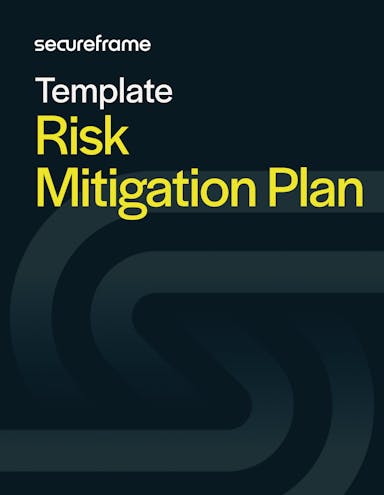There are multiple ways organizations can respond to risks. They can accept risks as is. They can transfer or share them. They can avoid them. They can remediate or resolve them. Or, they can minimize them to a level that is acceptable to the organization.
The latter is the most common risk response and a key part of a risk management strategy. Let’s dive into it below.
What is risk mitigation?
Risk mitigation refers to remedial or corrective actions taken to reduce the level of risk until it falls within the organizational risk tolerance.
Mitigating actions include operational processes, policies, and technologies designed to reduce the probability or impact of a risk. For example, conducting regular information systems backups can help mitigate the risk of accidental data loss.
Let’s take a look at some specific strategies and examples below.
Risk mitigation strategies
The strategies below can be used to reduce the likelihood of risk events or mitigate their consequences.
Risk substitution
Risk substitution involves substituting one risk for another with a lesser likelihood or estimated impact. An example would be replacing an incumbent technology with a new one that is more cyber resilient.
Risk isolation
Risk isolation refers to the isolation of a risk from other aspects of operations in order to minimize its impact. For example, you may choose to isolate legacy systems from sensitive data environments in order to mitigate the risk of a data breach.
Risk buffering
Buffering involves adding resources, time, or personnel to mitigate the potential impact of a risk. For example, duplicating critical servers or other infrastructure can reduce the risk of a critical system failure that leads to downtime and other disruptions in operations.
Recommended reading

How to Write a Business Continuity Plan + Template
Read MoreRisk mitigation examples
Still confused what risk mitigation means? Take a look at the examples below.
Example 1: Data backup
Let’s say that a company has two data centers. One is in North Carolina and one is in California. Each faces the respective risk of a hurricane or earthquake disrupting their operations. The likelihood that these disasters would occur on the same day is low, however. So a risk mitigation plan might be backing up each other’s data and systems every night. That way, if a disaster did occur at one data center and result in data loss, then the organization could recover it with the other center’s backup.
Example 2: Independent assessment
Jet Propulsion Laboratory (JPL), a division of NASA, faces significant risks throughout the product-development cycle because it constantly takes on long, complex, and expensive projects. So they established a risk review board made up of independent technical experts to evaluate their project engineers’ design, risk-assessment, and risk-mitigation decisions. This independent assessment helps reduce the probability and magnitude of risks, like missed deadlines and inadequate staffing.
Recommended reading

How to Write a Disaster Recovery Plan + Template
Read MoreWhat is a risk mitigation plan?
What is a risk mitigation plan?
A risk mitigation plan refers to the documented organizational strategy for mitigating risk. It generally highlights and outlines all the potential risks facing an organization along with different strategies and practices that risk managers and other employees should use to mitigate those risks.
The key to creating an effective plan is to identify the risks that are the most likely to occur or to have the biggest impact if they occur and prioritize mitigation efforts for them.
A risk matrix can be helpful in identifying your biggest priorities. You can then begin mitigating risks at the highest level and continue addressing the lower levels as time and resources allow.
Risk mitigation plan template
The template below can be used to help set an organizational risk mitigation strategy and align employees and other stakeholders to it. Or it can be used by teams and individuals to mitigate risks for specific projects.

Download the risk mitigation plan template
A risk mitigation plan refers to the documented organizational strategy for mitigating risk. Use this template to help set an organizational risk mitigation strategy and align employees and other stakeholders to it, or use it to mitigate risks for specific projects as an individual or group.